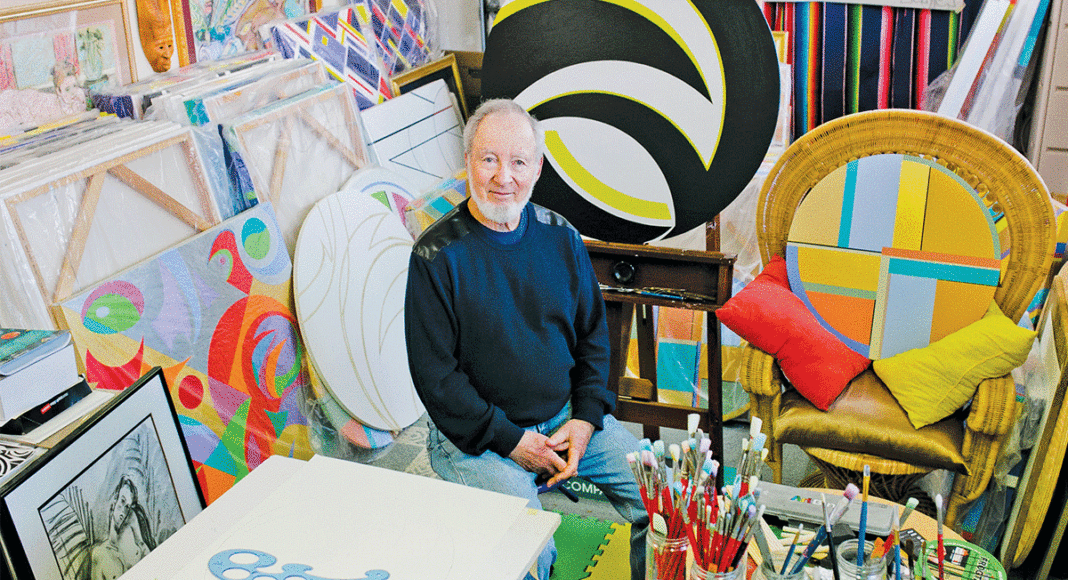[dropcap]I[/dropcap]mmersed in the art world from an early age, Ralph Joachim brings a historic legacy of abstract painting to bold artworks created in his tiny beach cottage studio at Pleasure Point.
Tall and lanky, with an easy smile and kind hands, Ralph Joachim is fully devoted to his lifelong passion—painting. Though his painting career was interrupted by his successful practice as a Bay Area attorney raising a large family, Joachim plunged back into studio work 20 years ago when he moved to Santa Cruz full-time.
“My father, grandmother, and uncle [the celebrated geometric abstractionist Ilya Bolotowsky] were all painters, so I grew up with painting in my blood,” he says, framed by a wall full of his bold canvases, on the eve of his 80th birthday. “Art was all around me, like breathing air. I’d been exposed to it for so long that it was only a question of developing my own work. And I also enjoyed good health and good fortune.”
“In painting geometric abstractions, I emphasize the universal elements of shape, design, color, and space relationships that are free from the limitations of realistic subject matter.” — Ralph Joachim
Admitting that he wanted to develop “some singular, expressive work,” Joachim early on turned away from figurative painting and began experimenting with precise, geometric abstractions himself. Starting with Mondrianesque grids of black and white, he began to explore more expressive angles and shapes with vibrant color accents. And those led to the large-scale, richly colored pieces he has exhibited recently at the Blitzer Gallery.
“In painting geometric abstractions, I emphasize the universal elements of shape, design, color, and space relationships that are free from the limitations of realistic subject matter,” he explains. As he leads me through his personal gallery and studio space, Joachim admits to aiming for something of a Platonic ideal of pure shape, “to explore the underlying geometry of nature, the beauty of pure physics.”
His large abstracts display the extreme discipline required to adhere to non-representational images. Think Mondrian and Kandinsky and you’ll have some idea of the rigorous color shapes Joachim explores, especially in his more recent circular panels. “Who knew that Home Depot would have these plywood rounds,” he says with a grin, as he points to recent studies, done—as is all of his work—in brilliant acrylic paint. Diagonals of yellow pierce slow curves of purple, white and black. “These need a very large wall,” he says, pointing to a lofty double triptych in black and white. “I envision a very large conclusion as I work, similar to a mural. I’m experimenting all the time—enjoying seeing where I can push abstraction.”
Joachim works solely in acrylics. “They’re fast-drying, and for geometric abstraction, that’s important. I can achieve perfect, flat volumes and edges. No uneven shading, that would interfere with the harmony. The volumes must be smooth and precise.” Plus, he says, “acrylic paint cleans up well.”
Confined by the size of his studio, he has designed large artworks made of many panels, “focusing on the whole.” The modular design allows him to create manageably sized pieces that ultimately fit together into monumental artworks with metaphysical themes, such as the Creation, space, and the universe.
“You can’t ever capture the Absolute,” he says, “but you can begin to approach visual insights that apply universally.”
Transfixed by the ocean just outside his double Dutch front door, Joachim is nothing if not persistent. “I’m willing to keep experimenting to create something original, and not let myself be distressed by individual failures,” he says.
Coming out West for law school, Joachim stayed and built his family, and now a satisfying art practice. “Art and nature are powerful connections,” he says, “and this is a beautiful place.”













I have been a long time admirer of Ralph’s work. Nice to see more public attention given to him.